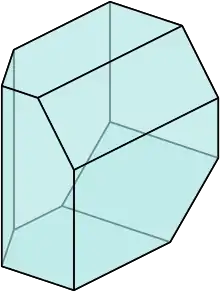polytope
English

A 3-dimensional Stasheff polytope
Etymology
From German Polytop, equivalent to poly- (“many”) + -tope (“surface”). Coined by Hoppe in 1882 and introduced to English by Alicia Boole Stott.[1]
Noun
polytope (plural polytopes)
- (geometry) A finite region of n-dimensional space bounded by hyperplanes (a geometric shape with flat sides, existing in any number of dimensions); the geometrical entity represented by the general term of the infinite sequence "point, line, polygon, polyhedron, ...".
- 1964, Victor Klee, On the Number of Vertices of a Convex Polytope, Canadian Journal of Mathematics, Volume XVI, Number 4, page 701,
- As is well known, the theory of linear inequalities is closely related to the study of convex polytopes.
- 1998, F. Pierrot, M. Benoit, P. Dauchez, SamoS: A Pythagorean Solution for Omnidirectional Underwater Vehicles, Jadran Lenar I, Manfred L. Husty (editors), Advances in Robot Kinematics: Analysis and Control, page 220,
- This polytope is mapped into a Cartesian force polytope (resp. torque polytope) in the Cartesian space. Such a polytope represents the exact force (resp. torque) that can be produced on the vehicle main body.
- 2006, Rekha R. Thomas, Lectures in Geometric Combinatorics, page 27,
- Verify the Hirsch conjecture for the 3-cube, 4-cube and any other polytope that takes your fancy.
- The Steinitz theorem is a very satisfactory understanding of the graphs of three-dimensional polytopes.
- 1964, Victor Klee, On the Number of Vertices of a Convex Polytope, Canadian Journal of Mathematics, Volume XVI, Number 4, page 701,
Hyponyms
- (geometrical figure): polygon (2d figure), polyhedron (3d figure), hypercube (generalised cube), simplex (generalised tetrahedron), tesseract (4d cube)
Translations
geometric shape
|
References
- 1910, A. Boole Stott, Geometrical deduction of semiregular from regular polytopes and space fillings, Verhandelingen of the Koninklijke academy van Wetenschappen width unit Amsterdam, Eerste Sectie 11,1, Amsterdam.
This article is issued from Wiktionary. The text is licensed under Creative Commons - Attribution - Sharealike. Additional terms may apply for the media files.